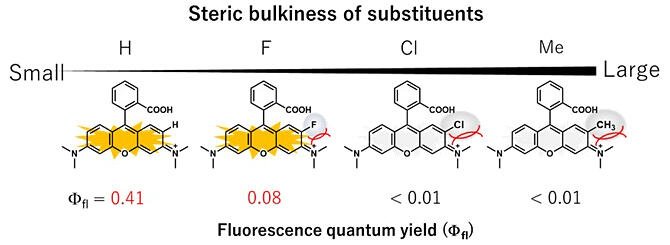Rhodamine fluorescent dye, known for nearly a century, has been used for the fluorescence imaging of living cells and animals. It was believed that the fluorescence characteristics of rhodamine fluorescent dye had been thoroughly investigated. However, a research group led by Professor Kenjiro Hanaoka of the Faculty of Pharmacy at Keio University has discovered new properties of this dye and successfully developed a novel fluorogenic probe that utilizes those properties. The results were published in Science Advances.

Fluorescence quenching was achieved by introducing a substituent at the ortho position of the dimethylamino group of tetramethylrhodamine, one of the rhodamine fluorescent dyes, which causes intramolecular twisting.
Provided by Keio University
The research group succeeded in introducing a substituent at the ortho position of the dimethylamino group of tetramethylrhodamine (one of the rhodamine fluorescent dyes), inducing intramolecular twisting and fluorescence quenching. This phenomenon was named steric repulsion-induced twisted intramolecular charge transfer (sr-TICT).
By utilizing this quenching structure, the researchers successfully developed a fluorogenic probe that detects the enzymatic activity (specifically N-dealkylation) of one subtype of the drug-metabolizing enzyme cytochrome P450, namely, CYP3A4. This probe exhibited a fluorescence increase of over 100-fold in detecting the enzymatic activity. CYP3A4 is involved in the metabolism of approximately half of all drugs, making this fluorogenic probe useful as a method for detecting drug-drug interactions.
Furthermore, by utilizing CYP3A4 as a marker to indicate the maturity of mature liver cells and intestinal epithelial cells, the research group successfully isolated and purified mature cells induced from human induced pluripotent stem cells (iPSCs) using the newly developed fluorogenic probe.
This research has made it possible to develop fluorogenic probes for biological phenomena, the development of which was previously challenging, thereby raising expectations for significant advancements in related research fields. A fluorogenic probe capable of detecting the activity of CYP3A4 (a key enzyme involved in the metabolism of pharmaceuticals in general) is expected to contribute to the fields of drug discovery and regenerative medicine.
Journal Information
Publication: Science Advances
Title: A general fluorescence off/on strategy for fluorogenic probes: Steric repulsion-induced twisted intramolecular charge transfer (sr-TICT)
DOI: 10.1126/sciadv.adi8847
This article has been translated by JST with permission from The Science News Ltd. (https://sci-news.co.jp/). Unauthorized reproduction of the article and photographs is prohibited.




